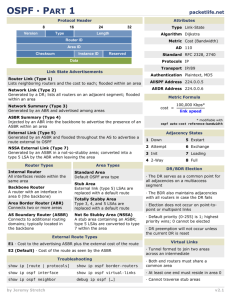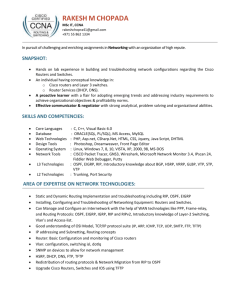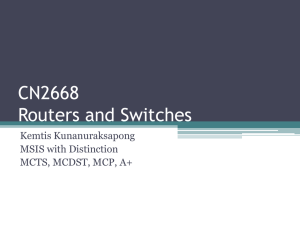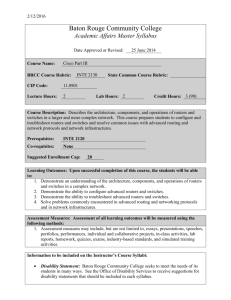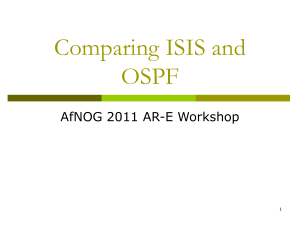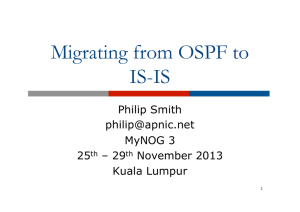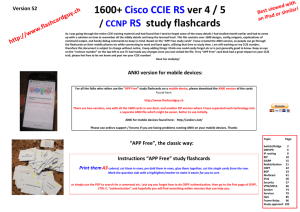Visio-Internal Routing Protocols Poster.vsd
advertisement
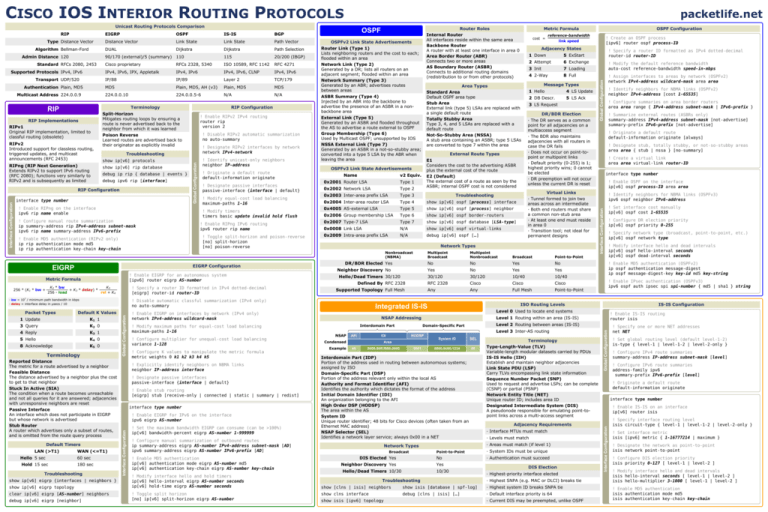
packetlife.net
Algorithm Bellman-Ford
Admin Distance 120
Standard RFCs 2080, 2453
Supported Protocols IPv4, IPv6
Transport UDP/520
Authentication Plain, MD5
Multicast Address 224.0.0.9
Link State
Link State
Path Vector
DUAL
Dijkstra
Dijkstra
Path Selection
90/170 (external)/5 (summary)
110
115
20/200 (IBGP)
Cisco proprietary
RFCs 2328, 5340
ISO 10589, RFC 1142
RFC 4271
IPv4, IPv6, IPX, Appletalk
IPv4, IPv6
IPv4, IPv6, CLNP
IPv4, IPv6
IP/88
IP/89
Layer 2
TCP/179
MD5
Plain, MD5, AH (v3)
Plain, MD5
MD5
224.0.0.5-6
RIPv2
Introduced support for classless routing,
triggered updates, and multicast
announcements (RFC 2453)
RIPng (RIP Next Generation)
Extends RIPv2 to support IPv6 routing
(RFC 2080); functions very similarly to
RIPv2 and is subsequently as limited
Split-Horizon
Mitigates routing loops by ensuring a
route is never advertised back to the
neighbor from which it was learned
Poison Reverse
Learned routes are advertised back to
their originator as explicitly invalid
show ip[v6] rip database
debug ip rip { database | events }
debug ipv6 rip [interface]
Interface Configuration
RIP Configuration
interface type number
! Enable RIPng on the interface
ipv6 rip name enable
! Identify unicast-only neighbors
neighbor IP-address
! Originate a default route
default-information originate
! Designate passive interfaces
passive-interface {interface | default}
! Modify equal-cost load balancing
maximum-paths 1-16
! Enable RIPng IPv6 routing
ipv6 router rip name
EIGRP Configuration
! Enable EIGRP for an autonomous system
[ipv6] router eigrp AS-number
Metric Formula
K5
K2 * bw
+ K3 * delay) *
256 - load
rel + K4
! Specify a router ID formatted in IPv4 dotted-decimal
[eigrp] router-id router-ID
· bw = 107 / minimum path bandwidth in kbps
· delay = interface delay in µsecs / 10
Router Link (Type 1)
Lists neighboring routers and the cost to each;
flooded within an area
Network Link (Type 2)
Generated by a DR; lists all routers on an
adjacent segment; flooded within an area
Network Summary (Type 3)
Generated by an ABR; advertises routes
between areas
ASBR Summary (Type 4)
Injected by an ABR into the backbone to
advertise the presence of an ASBR in a nonbackbone area
External Link (Type 5)
Generated by an ASBR and flooded throughout
the AS to advertise a route external to OSPF
Group Membership (Type 6)
Used by Multicast OSPF; unsupported by IOS
NSSA External Link (Type 7)
Generated by an ASBR in a not-so-stubby area;
converted into a type 5 LSA by the ABR when
leaving the area
Name
3 Query
K2 0
4 Reply
K3 1
5 Hello
K4 0
8 Acknowledge
K5 0
Terminology
Reported Distance
The metric for a route advertised by a neighbor
Feasible Distance
The distance advertised by a neighbor plus the cost
to get to that neighbor
Stuck In Active (SIA)
The condition when a route becomes unreachable
and not all queries for it are answered; adjacencies
with unresponsive neighbors are reset
Passive Interface
An interface which does not participate in EIGRP
but whose network is advertised
Stub Router
A router which advertises only a subset of routes,
and is omitted from the route query process
Default Timers
WAN (<=T1)
60 sec
180 sec
Troubleshooting
show ip[v6] eigrp {interfaces | neighbors }
show ip[v6] eigrp topology
clear ip[v6] eigrp [AS-number] neighbors
Global Configuration
K1 1
External Route Types
E1
Considers the cost to the advertising ASBR
plus the external cost of the route
E2 (Default)
The external cost of a route as seen by the
ASBR; internal OSPF cost is not considered
Type 1
0x2002 Network LSA
Type 2
0x2003 Inter-area prefix LSA
Type 3
0x2004 Inter-area router LSA
Type 4
show ip[v6] ospf [process] interface
0x4005 AS-external LSA
Type 5
show ip[v6] ospf [process] neighbor
0x2006 Group membership LSA
Type 6
show ip[v6] ospf border-routers
0x2007 Type-7 LSA
Type 7
show ip[v6] ospf database [LSA-type]
0x0008 Link LSA
N/A
show ip[v6] ospf virtual-links
0x2009 Intra-area prefix LSA
N/A
debug ip[v6] ospf […]
! Configure K values to manipulate the metric formula
metric weights 0 k1 k2 k3 k4 k5
! Designate passive interfaces
passive-interface {interface | default}
! Enable stub routing
[eigrp] stub [receive-only | connected | static | summary | redist]
interface type number
! Enable EIGRP for IPv6 on the interface
ipv6 eigrp AS-number
! Set the maximum bandwidth EIGRP can consume (can be >100%)
ip[v6] bandwidth-percent eigrp AS-number 1-999999
! Configure manual summarization of outbound routes
ip summary-address eigrp AS-number IPv4-address subnet-mask [AD]
ipv6 summary-address eigrp AS-number IPv6-prefix [AD]
! Enable MD5 authentication
ip[v6] authentication mode eigrp AS-number md5
ip[v6] authentication key-chain eigrp AS-number key-chain
! Modify interface hello and hold timers
ip[v6] hello-interval eigrp AS-number seconds
ip[v6] hold-time eigrp AS-number seconds
! Toggle split horizon
[no] ip[v6] split-horizon eigrp AS-number
5 ExStart
2 Attempt
6 Exchange
3 Init
7 Loading
4 2-Way
8 Full
1 Hello
4 LS Update
2 DB Descr.
5 LS Ack
3 LS Request
DR/BDR Election
· The DR serves as a common
point for all adjacencies on a
multiaccess segment
· The BDR also maintains
adjacencies with all routers in
case the DR fails
· Does not occur on point-topoint or multipoint links
· Default priority (0-255) is 1;
highest priority wins; 0 cannot
be elected
· DR preemption will not occur
unless the current DR is reset
Virtual Links
· Tunnel formed to join two
areas across an intermediate
· Both end routers must share
a common non-stub area
· At least one end must reside
in area 0
· Transition tool; not ideal for
permanent designs
Troubleshooting
Network Types
DR/BDR Elected Yes
Neighbor Discovery No
Hello/Dead Timers 30/120
Defined By RFC 2328
Supported Topology Full Mesh
Multipoint
Broadcast
Multipoint
Nonbroadcast
Broadcast
Point-to-Point
No
No
Yes
No
Yes
No
Yes
Yes
30/120
30/120
10/40
10/40
RFC 2328
Cisco
Cisco
Cisco
Any
Any
Full Mesh
Point-to-Point
AFI
Condensed
Example
HODSP
Area
49
0005.80ff.f800.0000
0001
System ID
SEL
0000.0c00.1234
00
Interdomain Part (IDP)
Portion of the address used in routing between autonomous systems;
assigned by ISO
Domain-Specific Part (DSP)
Portion of the address relevant only within the local AS
Authority and Format Identifier (AFI)
Identifies the authority which dictates the format of the address
Initial Domain Identifier (IDI)
An organization belonging to the AFI
High Order DSP (HODSP)
The area within the AS
System ID
Unique router identifier; 48 bits for Cisco devices (often taken from an
Ethernet MAC address)
NSAP Selector (SEL)
Identifies a network layer service; always 0x00 in a NET
DIS Elected Yes
Neighbor Discovery Yes
Adjacency Requirements
· Interface MTUs must match
· Levels must match
Point-to-Point
· System IDs must be unique
No
· Authentication must succeed
Yes
Hello/Dead Timers 10/30
Terminology
Type-Length-Value (TLV)
Variable-length modular datasets carried by PDUs
IS-IS Hello (IIH)
Establish and maintain neighbor adjacencies
Link State PDU (LSP)
Carry TLVs encompassing link state information
Sequence Number Packet (SNP)
Used to request and advertise LSPs; can be complete
(CSNP) or partial (PSNP)
Network Entity Title (NET)
Unique router ID; includes area ID
Designated Intermediate System (DIS)
A pseudonode responsible for emulating point-topoint links across a multi-access segment
· Areas must match (if level 1)
Network Types
Broadcast
10/30
Troubleshooting
DIS Election
· Highest-priority interface elected
· Highest SNPA (e.g. MAC or DLCI) breaks tie
show [clns | isis] neighbors
show isis [database | spf-log]
· Highest system ID breaks SNPA tie
show clns interface
debug [clns | isis] […]
· Default interface priority is 64
show isis [ipv6] topology
! Identify neighbors for NBMA links (OSPFv2)
neighbor IPv4-address [cost 1-65535]
! Configure summaries on area border routers
area area range { IPv4-address subnet-mask | IPv6-prefix }
! Summarize external routes (ASBRs only)
summary-address IPv4-address subnet-mask [not-advertise]
summary-prefix IPv6-prefix [not-advertise]
! Originate a default route
default-information originate [always]
! Designate stub, totally stubby, or not-so-stubby areas
area area { stub | nssa } [no-summary]
! Create a virtual link
area area virtual-link router-ID
interface type number
! Enable OSPF on the interface
ip[v6] ospf process-ID area area
! Identify neighbors for NBMA links (OSPFv3)
ipv6 ospf neighbor IPv6-address
! Set interface cost manually
ip[v6] ospf cost 1-65535
! Configure DR election priority
ip[v6] ospf priority 0-255
! Specify network type (broadcast, point-to-point, etc.)
ip[v6] ospf network type
! Modify interface hello and dead intervals
ip[v6] ospf hello-interval seconds
ip[v6] ospf dead-interval seconds
! Enable MD5 authentication (OSPFv2)
ip ospf authentication message-digest
ip ospf message-digest-key key-id md5 key-string
! Enable IPsec authentication (OSPFv3)
ipv6 ospf auth ipsec spi spi-number { md5 | sha1 } string
IS-IS Configuration
! Enable IS-IS routing
router isis
Level 2 Routing between areas (IS-IS)
Domain-Specific Part
IDI
! Assign interfaces to areas by network (OSPFv2)
network IPv4-address wildcard-mask area area
Level 1 Routing within an area (IS-IS)
Level 3 Inter-AS routing
NSAP
! Modify the default reference bandwidth
auto-cost reference-bandwidth speed-in-mbps
Level 0 Used to locate end systems
NSAP Addressing
Interdomain Part
! Specify a router ID formatted as IPv4 dotted-decimal
router-id router-ID
ISO Routing Levels
Integrated IS-IS
! Modify maximum paths for equal-cost load balancing
maximum-paths 1-16
! Configure multiplier for unequal-cost load balancing
variance 1-128
1 Down
Message Types
0x2001 Router LSA
! Create an OSPF process
[ipv6] router ospf process-ID
link speed
Adjacency States
Standard Area
Default OSPF area type
Stub Area
External link (type 5) LSAs are replaced with
a single default route
Totally Stubby Area
Type 3, 4, and 5 LSAs are replaced with a
default route
Not-So-Stubby Area (NSSA)
A stub area containing an ASBR; type 5 LSAs
are converted to type 7 within the area
v2 Equiv.
! Enable EIGRP on interfaces by network (IPv4 only)
network IPv4-address wildcard-mask
! Explicitly identify neighbors on NBMA links
neighbor IP-address interface
Interface Configuration
1 Update
reference-bandwidth
cost =
Area Types
OSPFv3 Link State Advertisements
! Disable automatic classful summarization (IPv4 only)
no auto-summary
Default K Values
debug ip[v6] eigrp [neighbor]
OSPFv2 Link State Advertisements
Nonbroadcast
(NBMA)
EIGRP
Hold 15 sec
! Designate RIPv2 interfaces by network
network IPv4-network
! Toggle split-horizon and poison-reverse
[no] split-horizon
[no] poison-reverse
! Enable MD5 authentication (RIPv2 only)
ip rip authentication mode md5
ip rip authentication key-chain key-chain
Hello 5 sec
! Disable RIPv2 automatic summarization
no auto-summary
! Modify timers
timers basic update invalid hold flush
! Configure manual route summarization
ip summary-address rip IPv4-address subnet-mask
ipv6 rip name summary-address IPv6-prefix
LAN (>T1)
! Enable RIPv2 IPv4 routing
router rip
version 2
Troubleshooting
show ip[v6] protocols
N/A
RIP Configuration
Global Configuration
RIPv1
Original RIP implementation, limited to
classful routing (obsolete)
Packet Types
N/A
Terminology
RIP Implementations
BGP
Distance Vector
224.0.0.10
RIP
256 * (K1 * bw +
IS-IS
· Current DIS may be preempted, unlike OSPF
Global Configuration
Type Distance Vector
OSPF
OSPF Configuration
! Specify one or more NET addresses
net NET
! Set global routing level (default level-1-2)
is-type { level-1 | level-1-2 | level-2-only }
! Configure IPv4 route summaries
summary-address IP-address subnet-mask [level]
! Configure IPv6 route summaries
address-family ipv6
summary-prefix IPv6-prefix [level]
! Originate a default route
default-information originate
interface type number
! Enable IS-IS on an interface
ip[v6] router isis
Interface Configuration
EIGRP
Metric Formula
Global Configuration
RIP
Router Roles
Internal Router
All interfaces reside within the same area
Backbone Router
A router with at least one interface in area 0
Area Border Router (ABR)
Connects two or more areas
AS Boundary Router (ASBR)
Connects to additional routing domains
(redistribution to or from other protocols)
OSPF
Interface Configuration
Unicast Routing Protocols Comparison
! Specify interface routing level
isis circuit-type { level-1 | level-1-2 | level-2-only }
! Set interface metric
isis [ipv6] metric { 1-16777214 | maximum }
! Designate the network as point-to-point
isis network point-to-point
! Configure DIS election priority
isis priority 0-127 [ level-1 | level-2 ]
! Modify interface hello and dead intervals
isis hello-interval seconds [ level-1 | level-2 ]
isis hello-multiplier 3-1000 [ level-1 | level-2 ]
! Enable MD5 authentication
isis authentication mode md5
isis authentication key-chain key-chain

